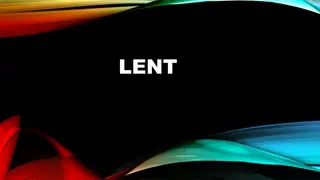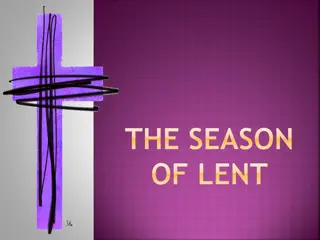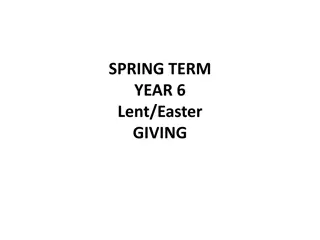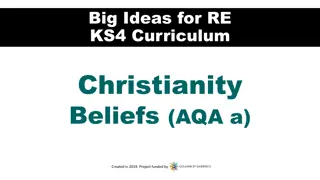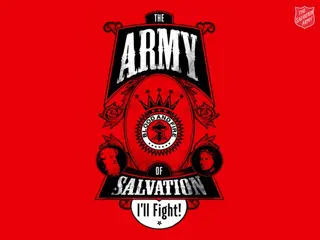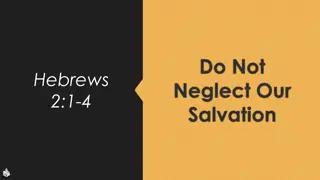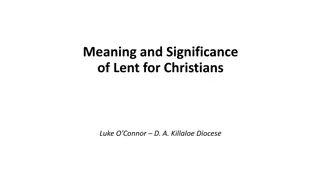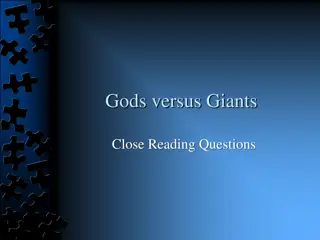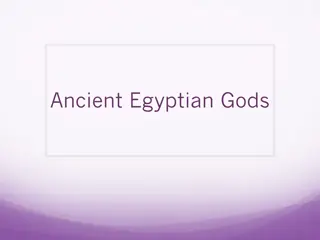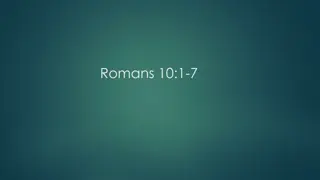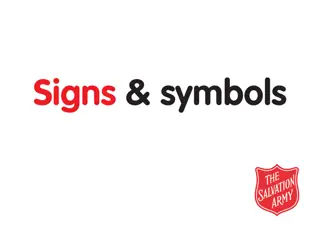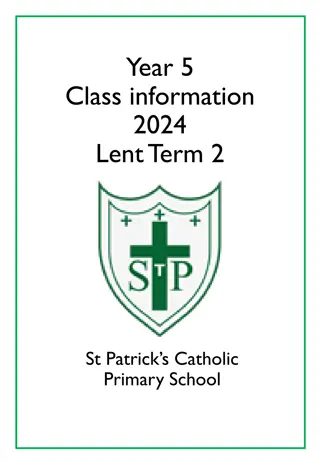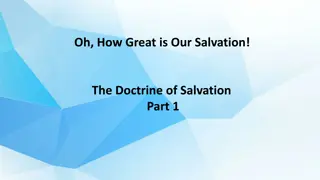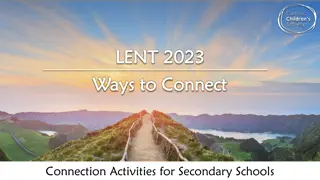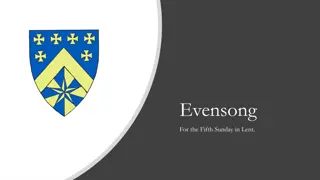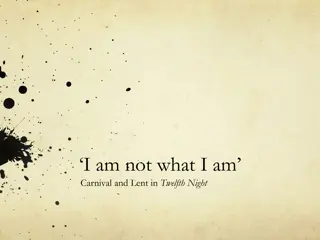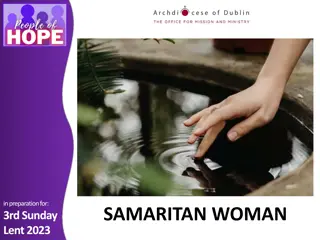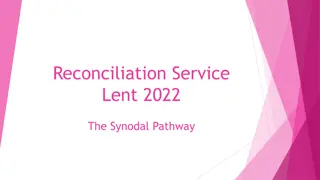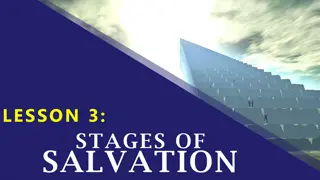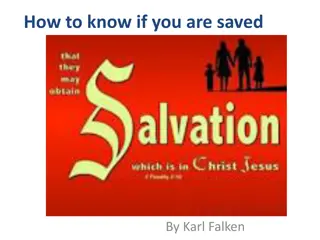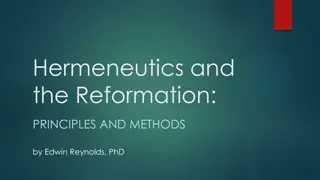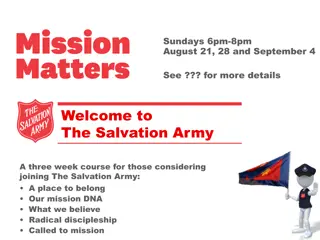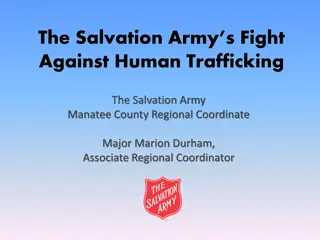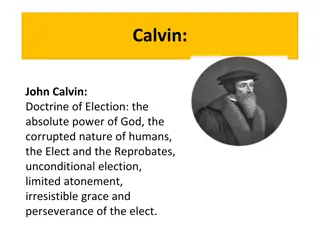Understanding God's Plan for Salvation in Lent 2024
Explore the significance of God's plan to rescue humanity and creation as depicted through key Biblical narratives from Genesis to Malachi. Discover the theological insights behind the seven-day creation account and the context of God's rescue strategy from Genesis 1-11. Reflect on the covenantal relationships established by God with figures like Noah, Abraham, and Israel, envisioning a new day of redemption and renewal. Dive deep into the Old Testament narrative and its relevance for Lenten reflections in 2024.
Download Presentation

Please find below an Image/Link to download the presentation.
The content on the website is provided AS IS for your information and personal use only. It may not be sold, licensed, or shared on other websites without obtaining consent from the author. Download presentation by click this link. If you encounter any issues during the download, it is possible that the publisher has removed the file from their server.
E N D
Presentation Transcript
Lent 2024 djscholz@stritch.edu
Parish Mission: Day 1 The First Readings The First Readings of Lent 2024 of Lent 2024 God s Plan to Rescue Us and the World Retrieving the Old Testament narrative
Gods plan to rescue us and creation: Genesis 9:8-15 God s covenant with Noah Genesis 22:1-18 God s covenant with Abraham Exodus 20:1-17 God s Law for Israel 2 Chronicles 36:14-23 Israel s exile & return from Babylon Jeremiah 31:31-34 God s new covenant with Israel In accordance with the Scriptures (1 Cor 15:3 (1 Cor 15:3- -4) 4)
The sweep of Israels Scriptures from Genesis to Malachi
The seven-day creation account: the Hebrew verb br means create and concerns the function of the cosmos and not the material shape of the cosmos. Israel believed God created by assigning functions and functionaries throughout the heavens and the earth. After each day (period) when God said, it is good, readers would have heard each function is now operating well and aligned to God s purposes and direction. So o Day 1-3 God established the functions of time, weather and food the foundations of life. o Day 4-6 God installed the functionaries of celestial bodies and living creatures, with the final installment of humans (male and female) as imago dei in charge of his creation. The human vocation is to reflect God s presence in the world at the intersection of heaven and earth. o Day 7 God came to earth to rest (in Hebrew, bat) and dwell with his creation with his image-bearing humans as his stewards. God came to rest in the temple (the cosmos) so he could now establish his rule. In the beginning
Genesis 1-11 The context of God s rescue The seven-day creation account o God designs creation for the benefit of humanity Adam and Eve and the first exile o God reacts to disobedience and idolatry Cain and Abel and the spread of sin o God s mercy shown in the mark of Cain From Adam to Noah, God s grieving (in Hebrew, yin'n hem) o God remains in control: Return to chaos then re- creation o Genesis 9:8-15 God initiates his covenantal strategy the promise of a new day. Tower of Babel and the persistence of sin o God rejects human idolatry Genesis 1-11 gives meaning and shape to the story of Israel.
Gods response to Adam: Abraham God s master plan to put things right ( justification ) Abraham: Genesis 22:1-18 Through Abraham, a barren, wandering nomad, God enters into a covenant originally offered to Adam (be fruitful and multiply and rule over all the earth): o Descendants as numerous as the stars o Possession of all lands o All nations blessed through you All this because you obeyed my command. Gen 22:18
Moses/Exodus, the Law, and the wilderness Tabernacle God heard their moaning and God was mindful of his covenant with Abraham. Exodus 2:24 Moses and the Exodus of Israel the first Passover. Giving of the Law (Torah) and birth of the nation of Israel: chosen, holy, the light to the world. Exodus 20:1-7 o Remember, keep holy bat. The golden calf Israel s return to idolatry. The wilderness Tabernacle (heaven and earth overlap and interlock) God s shekinah (divine presence) restored in creation: o The glory of the Lord filled the Tabernacle. Exodus 40:35 o Israel s Tabernacle as the micro-cosmos.
Deuteronomy 27-29, 30:15-20 Moses to the Israelites on the eve of entry into the Promised Land: you must choose between life and death, the blessing and the curse. Now, if you obey me completely and keep my covenant, you will be my treasured possession among all peoples, though all the earth is mine. You will be a kingdom of priests, a holy nation. Exodus 19:5-6
Promised Land & Monarchy: David, Solomon and Israel s Temple The anointing of David as King (1 Sam 16). The Davidic Covenant (2 Samuel 7:8-16): I will give you rest from all your enemies I will raise up your offspring after you, sprung from your loins, and I will establish his kingdom and I will establish his throne forever. King Solomon and the building of Israel s first Temple (heaven and earth unite and overlap) 1 Kings 8, the dedication of the Temple (God s shekinah at rest) in Jerusalem: When the priests left the holy place, the cloud filled the house of the Lord so that the priests could no longer minister because of the cloud, since the glory of the Lord had filled the house of the Lord. 1 Kings 8:10-11 From the wilderness Tabernacle to the Promised Land s Temple: God s micro-cosmos is expanding.
Fall of the Monarchy and Exile in Babylon After the death of King Solomon (922 BC), the United Monarchy split into the North (Israel) and South (Judah). The northern kingdom (10 tribes) were destroyed by the Assyrians in 721 BC. The southern kingdom (2 tribes) were destroyed by the Babylonians and exiled to Babylon in 597/587 BC. 2 Chronicles 26:14-23 And the curse-prophesy of Moses is fulfilled: Because they abandoned the covenant of the Lord, the God of their ancestors, which he made with them when he brought them out of the land of Egypt, and they went and served other gods and bowed down to them The Lord uprooted them from their soil in anger, fury, and great wrath, and cast them out into another land. Exodus 29:24-27
Rise of the Prophets The period between the fall of the Monarchy (922BC) and the Babylonian Exile (597-538BC) gave rise to the classic prophets who warned Israel against their idolatry and covenantal disobedience. The three major prophets were Isaiah, Jeremiah and Ezekiel. While the prophets were critical, they also offered messages of hope (Is 40-55; Jer 30-35; Ez 33-48): The days are coming, says the Lord, when I will make a new covenant with the house of Israel and the house of Judah I will place my law within them and write it on their hearts I will forgive their evildoing and remember their sins no more. Jeremiah 31:31-34
Two prophets of the Babylonian Exile: Ezekiel and Second Isaiah Second Isaiah 40-55 Ezekiel 10-11 Comfort, give comfort to my people, says your God. (538 BC) Isaiah 40:1 On the fifth day of the sixth month, in the sixth year (September 17, 592 BC) Ezekiel 10:1 (God s shekinah leaves the Temple in Jerusalem) (The great promise [poem] of God s return)
Daniel and Israels extended exile, Second Temple Judaism, Sabbath, Temple Second Temple Judaism: 515BC-70AD Second Temple Jews knew well Daniel s prophetic words: Israel would experience an extended exile because Israel was still in its sin (7x70=490 years) Dan 9:24 As long as Israel was still in bondage from hostile powers due to sin, what was needed was a new Exodus. Sabbath (heaven + earth time) Temple (heaven + earth space)
What emerges from Genesis to Chronicles: The Jewish backstory Temple cosmology Sabbath eschatology Imago Dei anthropology
Parish Mission: Day 1 The First Readings The First Readings of Lent 2024 of Lent 2024 God s Plan to Rescue Us and the World Retrieving the Old Testament narrative


